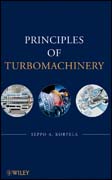
The aim of the proposed book, titled Principles of Turbomachinery, is to provide students and professionals a readable text/reference book. The aim is to keep the level such that students can smoothly move from a study of the most successful books in thermodynamics, fluid dynamics, and heat transfer to the subject of turbomachinery. The chapters are organized in such a way that the moredifficult material is left to the later sections of each chapter. Thus, depending on the level of the students, instructors can tailor their course by omitting some sections. The proposed textbook is based on a course on turbomachinery which the author has taught since year 2000 as a technical elective. Topicsinclude; Energy Transfer in Turbomachines, Gas and Steam Turbines, and Hydraulic Turbines. New material on wind turbines, and three-dimensional effects in axial turbomachines are included in the present prospectus. INDICE: List of Figures. List of Tables. Foreword. Acknowledgments. 1. Introduction. 1. Energy and fluid machines. 1.2 Historical survey. 2. Principles of Thermodynamics and Fluid Flow. 2.1 Mass conservation principle. 2.2 First Law of thermodynamics. 2.3 Second law of thermodynamics. 2.4 Equations of state. 2.5 Efficiency. 2.6 Momentum balance. 3. Compressible Flow through Nozzles. 3.1 Mach number and the speed of sound. 3.2 Isentropic flow with area change. 3.3 Normal shocks. 3.4 Influence of friction in flow through straight nozzles.3.5 Supersaturation. 3.6 Prandtl-Meyer expansion. 3.7 Flow leaving a turbine nozzle. 4. Principles of Turbomachine Analysis. 4.1 Velocity triangles. 4.2 Moment of momentum balance. 4.3 Energy transfer in turbomachines. 4.4 Utilization. 4.5 Scaling and similitude. 4.6 Performance characteristics. 5. Steam Turbines. 5.1 Introduction. 5.2 Impulse turbines. 5.3 Stage with zero reaction. 5.4Loss coefficients. 6. Axial Turbines. 6.1 Introduction. 6.2 Turbine state analysis. 6.3 Flow and loading coefficients and reaction ratio. 6.4 Three-dimensional flow. 6.5 Radial equilibrium. 6.6 Constant mass flux. 6.7 Turbine efficiency and losses. 6.8 Multistage turbine. 7. Axial compressors. 7.1 Compressor stage analysis. 7.2 Design deflection. 7.3 Radial equilibrium. 7.4 Diffusion and losses. 7.5 Cascade aerodynamics. 8. Centrifugal Compressors and Pumps. 8.1 Compressor analysis. 8.2 Inlet design. 8.3 Exit design. 8.4 Vaneless diffuser.8.5 Centrifugal pumps. 8.6 Fans. 8.7 Cavitation. 8.8 Diffuser and Volute design. 9. Radial Inflow Turbines. 9.1 Turbine analysis. 9.2 Efficiency. 9.3 Specific speed and specific diameter. 9.4 Stator flow. 9.5 Design of the inlet of aradial inflow turbine. 9.6 Design of the Exit. 10. Hydraulic Turbines. 10.1 Hydroelectric Power Plant. 10.2 Hydraulic turbines and their specific speed. 10.3 Pelton wheel. 10.4 Francis turbine. 10.5 Kaplan turbine. 10.6 Cavitation. 11. Hydraulic Transmission of Power. 11.1 Fluid couplings. 11.2 Torque converters. 12. Wind turbines. 12.1 Horizontal axis wind turbine. 12.2 Momentum and blade element theory of wind turbines. 12.3 Blade Forces. 12.4 Turbomachinery and future prospects for energy. Appendix A. Streamline curvature and radial equilibrium. Appendix B. Thermodynamic Tables. References. Index.
- ISBN: 978-0-470-53672-8
- Editorial: John Wiley & Sons
- Encuadernacion: Cartoné
- Páginas: 455
- Fecha Publicación: 04/11/2011
- Nº Volúmenes: 1
- Idioma: Inglés
